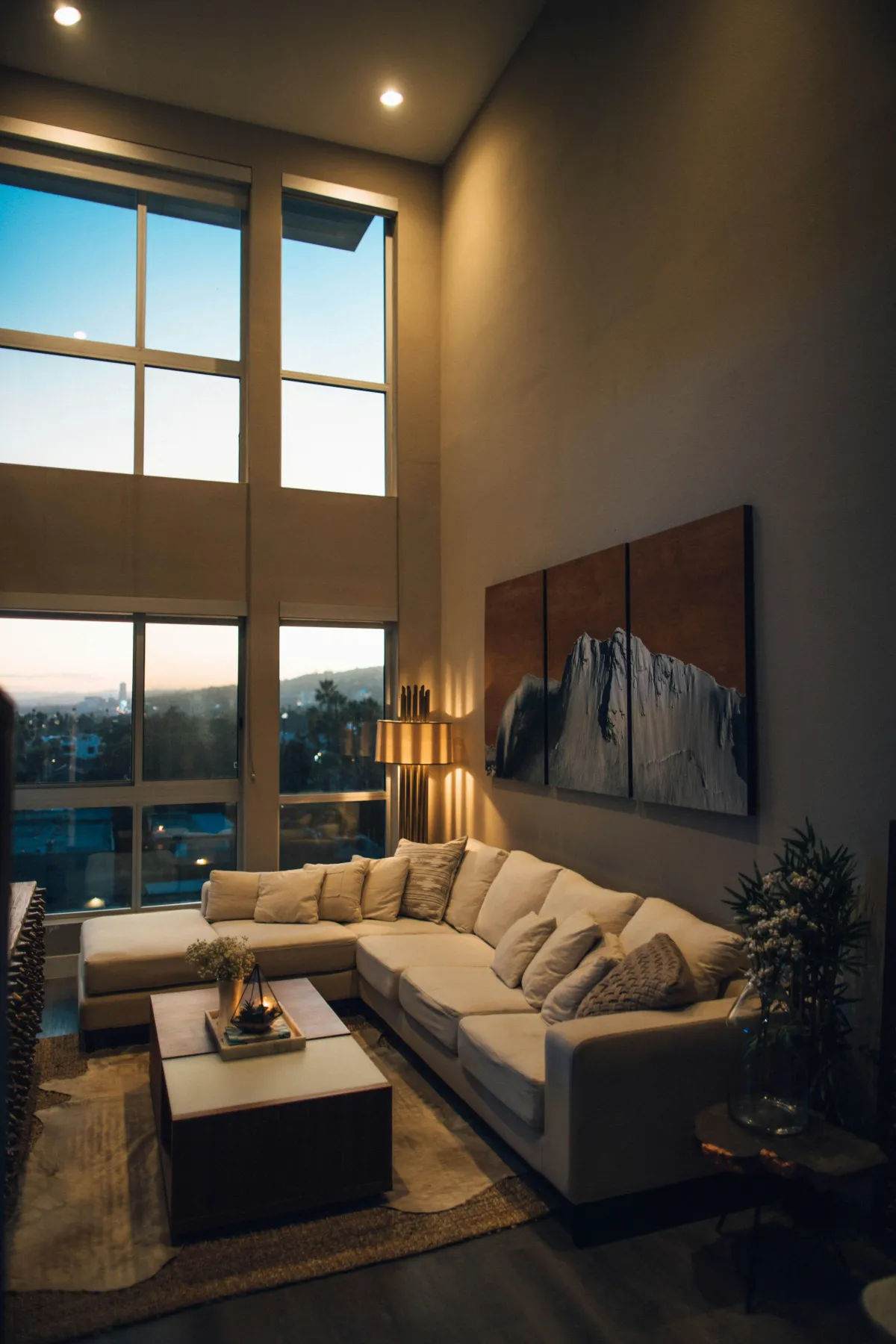
Contemporary Interior Design Secrets for Small Spaces
Designing a small home doesn't mean compromising on comfort, beauty, or functionality. With the right strategies, even the most compact spaces can feel expansive, organized, and tailored to your lifestyle. Contemporary interior design offers clean lines, smart storage, and intentional styling to make every square foot count. Whether you're building from scratch or renovating a tight layout, thoughtful design choices transform limitations into standout features. This guide explores practical, stylish, and space-conscious solutions that make small homes feel open and modern.
Key Takeaways
Smart design choices make small spaces feel larger through open layouts, neutral palettes, and multi-functional furniture.
Built-in storage and vertical solutions help reduce clutter while preserving a clean, minimalist aesthetic.
Lighting and reflective surfaces enhance brightness and depth, making rooms appear more open and inviting.
Professional guidance streamlines the design process, ensuring efficient use of space, cohesive style, and fewer costly mistakes.
Modern tech integrations like smart lighting and controls boost convenience without taking up physical space.
How Can Multifunctional Furniture Transform Small Contemporary Homes?

Multifunctional furniture makes it possible to enjoy comfort and style without crowding a small space. In a compact home, pieces that double up—like beds with drawers or tables with storage—maximize every inch. This type of design simplifies organization and supports an open, contemporary look. It also makes the space adaptable for different needs, from hosting guests to working from home. Choosing pieces with slim silhouettes and clean lines keeps the look modern while improving daily function. With the right planning, even the smallest home can feel expansive and stylish. The key lies in balancing utility with design simplicity.
What Is Multifunctional Furniture and Why Is It Essential for Small Spaces?
Multifunctional furniture is designed to serve multiple roles, like storage ottomans, sofa beds, or foldable desks. These pieces reduce the number of individual items needed in a space, freeing up square footage while keeping essentials accessible. In small homes, this furniture style supports a minimalist layout without sacrificing comfort. For example, a coffee table with interior storage can eliminate the need for separate shelving. Slim profiles and smart materials help maintain a light, open look. Selecting multi-use items during the design phase ensures functionality without adding clutter. It’s one of the smartest ways to merge style with everyday living.
Which Types of Multifunctional Furniture Best Suit Contemporary Interiors?
In contemporary homes, furniture should combine clean aesthetics with functional features. Sofa beds are perfect for flexible living rooms or guest areas. Ottomans with hidden compartments offer seating and storage in one unit. Drop-leaf tables or wall-mounted desks adapt to changing needs, from meals to remote work. Modular shelving systems double as room dividers and storage. Floating vanities and built-ins preserve floor space while increasing utility. When selected carefully, these pieces complement open layouts and enhance room flow. Their sleek, practical design makes them staples in modern small-space planning. Prioritizing these items helps maintain order and visual balance.
How Do You Integrate Multifunctional Furniture Without Sacrificing Style?
Start by choosing pieces that align with your interior design theme—stick to neutral tones, matte finishes, and clean shapes. Avoid bulky or overly decorative options that dominate the room. Integrate furniture gradually, making sure each piece supports both function and visual cohesion. Position fold-out furniture near walls or windows to maximize usability and light. Accent with layered textiles to soften lines without overwhelming the space. Focus on balance—every item should contribute to storage or utility without interrupting the flow. With the right placement and proportions, multifunctional furniture can elevate both form and function in small interiors.
What Are the Best Vertical Storage Solutions for Modern Small Spaces?

Vertical storage takes advantage of wall height to reduce floor clutter and improve organization. In small contemporary homes, it helps create a cleaner visual layout and increases usable space without sacrificing style. Wall-mounted shelves, slim cabinets, and tall built-ins blend seamlessly with modern aesthetics. These solutions allow for better flow in narrow layouts while supporting practical storage needs. They also draw the eye upward, giving the illusion of higher ceilings and a more open feel. When paired with the right lighting and finishes, vertical storage becomes both functional and decorative. It’s a must-have feature in efficient interior planning.
How Does Vertical Storage Maximize Usable Space in Small Homes?
By shifting storage upward, vertical systems free up floor area for movement and multi-use zones. Tall cabinetry, shelving units, or wall hooks offer ways to store everyday items without crowding. These setups can be customized for specific needs—kitchen essentials, home office supplies, or personal items. Even narrow corners can house a floor-to-ceiling unit that makes use of overlooked areas. In living rooms, wall-mounted bookcases double as décor and storage. Entryways benefit from vertical racks and slim closets. The result is a more open, organized home that still meets functional demands. It’s a smart strategy for compact living.
What Are Effective Vertical Storage Options for Contemporary Apartments?
Contemporary interiors favor clean lines and simple materials, which makes floating shelves and handleless cabinets ideal. Peg rails with modular hooks suit both kitchens and bedrooms, offering flexibility in how space is used. Slim ladder-style shelving units provide a stylish place for books or décor. Tall wardrobes with interior organizers make clothing storage more efficient. Wall-mounted bathroom cabinets keep essentials within reach without adding bulk. Corner shelves utilize dead space while contributing to room balance. All of these options support clutter-free living while reinforcing a sleek, modern look. They’re highly effective in apartments where every inch counts.
How Can You Combine Vertical Storage with Contemporary Aesthetics?
The key is to blend function with subtle, refined design choices. Use matte finishes, matching tones, and concealed hardware for a cohesive visual. Integrated lighting beneath shelves can highlight items while enhancing ambiance. Materials like wood veneer, metal, or frosted glass work well with modern color palettes. Avoid overcrowding—leave open areas between vertical elements to maintain an airy feel. Incorporate symmetry when installing shelving or cabinets to reinforce a clean layout. Let functional storage double as display for curated pieces. With thoughtful planning, vertical storage becomes a seamless part of your contemporary interior’s visual rhythm.
How Does Open Concept Living Enhance Contemporary Small Apartments?

Open concept living eliminates unnecessary partitions, promoting better light flow, visibility, and a sense of spaciousness. In small homes, removing walls between common areas like the kitchen, dining, and living rooms creates multifunctional zones that feel larger and more connected. This design style supports the modern preference for fluid movement and visual cohesion. Without visual barriers, natural light reaches farther, brightening the entire layout. It also allows for more flexible furniture arrangements, which are crucial when space is limited. Open layouts offer both form and function, blending aesthetics with everyday usability in compact homes.
What Are the Benefits of Open Floor Plans in Small Contemporary Spaces?
Open floor plans allow a small space to serve multiple functions without feeling cramped. By eliminating walls, a single area can be adapted throughout the day for working, eating, relaxing, or entertaining. This design also improves air circulation and lighting reach, reducing the need for extra fixtures or fans. The streamlined layout helps cut down on furniture bulk by replacing separate sets with shared items like dining benches or sectional sofas. Open floor plans invite social interaction and give an apartment a unified personality. They make everyday activities more convenient while elevating the sense of luxury.
How Do You Define Zones Without Walls in Open Concept Designs?
Using visual cues, furniture placement, and lighting allows homeowners to define areas without physical dividers. Rugs can anchor a seating area, while pendant lighting highlights a dining table. Furniture like couches or shelving units act as informal dividers that preserve sightlines but create structure. Different wall colors or textures can also subtly distinguish one space from another. This method maintains flow while organizing functions effectively. Smart zoning enhances flexibility, allowing each part of the home to serve its purpose. The overall result is a well-ordered layout that still feels open, airy, and modern.
Which Furniture Layouts Support Open Concept Living in Compact Homes?
Choose multifunctional pieces that suit multiple purposes across zones. Modular sofas can be reconfigured to suit gatherings or quiet time, while narrow dining tables double as desks. Low-profile furniture like open shelving keeps lines of sight clear. Placing a rug under the main sitting area separates it from dining or entry spaces. Lightweight items on wheels make rearranging simple, giving residents control over space.
How Do Color Palettes Influence the Perception of Small Contemporary Interiors?

Thoughtful color selection can dramatically shift how a compact space feels. Light and neutral shades make walls recede visually, giving the illusion of depth and openness. Soft tones also create a consistent visual flow between connected rooms in open layouts. In small homes, using one continuous color or coordinating palette across walls, cabinetry, and flooring helps reduce visual clutter. Accent hues can then be added sparingly to provide contrast without shrinking the space. The right palette balances calm, cohesion, and style, aligning with contemporary design goals.
Which Light and Neutral Colors Make Small Rooms Feel Larger?
Using pale tones like off-white, sand, and muted gray helps reflect more light throughout the space. These shades blur boundaries between walls, ceilings, and floors, visually stretching the room’s proportions. Light finishes also enhance the effect of natural and artificial lighting, amplifying brightness and clarity. In kitchens and bathrooms, light-toned cabinetry and countertops prevent tight areas from feeling boxed in. Avoid dark or saturated colors on large surfaces, as they can absorb light and draw attention inward. Consistency is key—matching trim, ceiling, and wall colors keeps transitions seamless.
How Can Bold Accents Be Used Effectively in Small Contemporary Spaces?
Bold colors should be used sparingly to maintain openness while adding personality. A single statement wall or a cluster of accent items like artwork or cushions introduces energy without overwhelming. Deep hues like navy, charcoal, or forest green work well in accessories or furniture pieces to ground a light backdrop. Stick to one or two accent colors per room to avoid visual chaos. Balance them with neutral surroundings so that the space still feels airy. Carefully placed accents draw the eye and highlight design details without reducing visual square footage.
What Are the Best Color Combinations for a Calming Contemporary Atmosphere?
Pairing neutral bases with soft, earthy tones creates balance and warmth. Light gray or beige walls can be complemented by muted greens, taupe, or dusty blue accents. White trim and ceilings maintain brightness and structure, while darker elements like charcoal furnishings anchor the palette. Soft textures in complementary colors—such as woven throws or rugs—help tie the scheme together. Avoid harsh contrasts, opting instead for gradual shifts between tones to keep the aesthetic relaxed and cohesive. This strategy fosters a calm, welcoming atmosphere in even the smallest footprint.
How Can Natural Light and Mirrors Be Leveraged to Enlarge Small Contemporary Homes?

Natural light and reflective surfaces play a major role in transforming compact interiors into bright, expansive spaces. Open layouts with unobstructed windows allow sunlight to travel deeper into rooms. Mirrors amplify that light, making the environment feel open and energizing. Strategically placed windows and reflective finishes enhance depth perception without structural changes. These design elements also reduce the need for artificial lighting during the day. Together, they support both visual spaciousness and energy efficiency in small, modern homes.
Why Is Natural Light Crucial for Small Contemporary Interiors?
Natural light improves mood, increases perceived space, and highlights architectural features. In small rooms, it prevents shadow-heavy corners that can make areas feel cramped. Skylights, large windows, or glass doors allow light to reach central zones like kitchens or living rooms. Transom or interior glass panels can also share daylight between rooms without compromising privacy. The goal is to ensure daylight reaches as much of the interior as possible. Maximizing sunlight not only enhances design but also supports healthier, more inviting living environments.
How Do Mirrors Amplify Light and Create the Illusion of Space?
When positioned thoughtfully, mirrors bounce natural and artificial light across the room, doubling brightness and expanding sightlines. Floor-length mirrors on walls opposite windows enhance depth and reflect outdoor views indoors. Mirrored cabinets or furniture elements contribute to a more open look without clutter. Even small touches like mirrored tiles or glossy finishes can redirect light. This technique visually pushes back walls, making spaces appear wider and taller. It’s one of the most effective design strategies in small-space planning.
What Reflective Surfaces Complement Contemporary Small Space Design?
Glass, high-gloss laminate, and polished metals fit seamlessly into modern interiors while enhancing brightness. A mirrored backsplash in the kitchen or a chrome light fixture in the hallway introduces reflectivity without adding bulk. Smooth surfaces on cabinetry or doors help maintain a clean, streamlined look. Pairing reflective materials with matte finishes like soft textiles or painted walls adds contrast and dimension. These surfaces serve both practical and aesthetic functions, reinforcing openness while preserving a cohesive, contemporary tone.
What Textures and Materials Best Suit Compact Contemporary Design?

In small contemporary spaces, textures and materials should create comfort, warmth, and visual interest—without overwhelming the layout. Carefully layered finishes help avoid flat, lifeless interiors while maintaining the clean aesthetic typical of modern homes. From natural wood and woven fabrics to matte surfaces and light-reflecting elements, each material plays a role in shaping a functional yet stylish living space. Selecting the right mix ensures that even compact interiors feel rich, welcoming, and thoughtfully designed from floor to ceiling.
How Do Natural Materials Enhance Small Contemporary Interiors?
Wood, linen, stone, and woven elements add natural warmth and texture that soften modern geometry. A wooden coffee table or floating shelf introduces subtle contrast against white walls. Textiles like cotton and wool in throws or curtains offer tactile variety without adding clutter. Using wood-grain flooring or stone countertops brings an organic touch that grounds the space. These materials balance the clean lines of minimalism with character. When used strategically, they elevate both function and comfort in a small footprint.
Which Textures Add Depth Without Overwhelming Small Spaces?
Fine, low-profile textures like matte paints, flat-weave rugs, and soft-touch upholstery enhance depth without crowding the layout. Avoid heavily embossed patterns or overly plush finishes, which can make rooms feel tighter. Use subtle stripes or tone-on-tone weaves to introduce quiet movement. Smooth textures on walls and cabinets create visual calm, while layering in a few varied materials adds richness. This balance prevents monotony and gives the space visual layers that feel intentional and polished.
How Can Sustainable Materials Be Incorporated in Contemporary Small Homes?
Eco-conscious materials like reclaimed wood, bamboo, cork, and recycled glass support sustainability and modern design. Low-VOC paints and sealants improve indoor air quality, especially in tight layouts. Modular furniture made with renewable resources ensures efficiency and environmental responsibility. Many sustainable options also offer a natural, tactile appeal that fits small homes well. When selected wisely, these materials reduce environmental impact and elevate the overall experience of modern small-space living.
Frequently Asked Questions
What Makes Contemporary Design Effective in Small Spaces?
Contemporary design uses clean lines, open layouts, and minimal décor to create a sense of spaciousness. With neutral tones, smart lighting, and multi-use furniture, small spaces feel brighter, more open, and better organized.
How Can I Maximize Space With Custom Interior Design Solutions?
Smart interior design uses tailored solutions like built-ins, modular layouts, and vertical storage to reduce clutter. Professional guidance ensures every element fits the home’s layout and lifestyle needs.
What Are the Key Elements of Functional Furniture in Small Homes?
Functional furniture serves more than one purpose—like ottomans with storage or fold-out desks. These pieces reduce visual clutter and support flexible layouts without sacrificing comfort or style.
How Do I Incorporate Storage Without Adding Bulk?
Use vertical storage, recessed shelving, and built-ins that blend with the wall. Keep profiles slim and surfaces clean to maintain a spacious look while keeping items organized.
What Lighting Strategies Make a Small Space Feel Larger?
Layer natural and artificial lighting to brighten the room and add depth. Recessed fixtures, mirrors, and light-toned finishes help open up space without adding bulk.
Why Is Hiring a Professional Designer Worth It for Small Interiors?
Designers understand space planning, storage, and styling for compact homes. Custom Builder Connection connects you with vetted experts who can optimize layouts and elevate design results.
How Can I Start a Small Space Interior Design Project With Support?
Start by outlining your goals and space challenges. Then connect with trusted experts through Custom Builder Connection to design solutions that fit your layout, style, and budget.
Conclusion
Living in a smaller home is no longer a limitation—it’s an opportunity to simplify, personalize, and elevate your lifestyle through smart design. From multifunctional furniture to vertical storage, lighting tricks, and integrated technology, each decision plays a role in creating a balanced, livable environment. With a focus on clean aesthetics and functional use of space, contemporary interiors bring harmony to compact homes. When paired with expert support from seasoned professionals, these design solutions help you make the most of your space without sacrificing your style or comfort.


